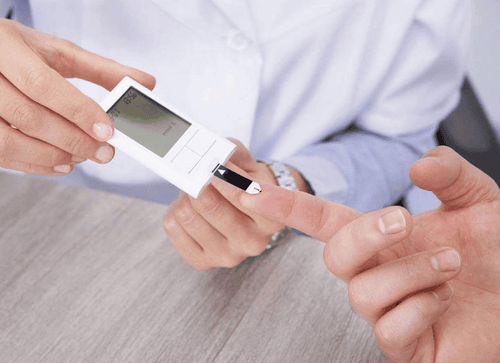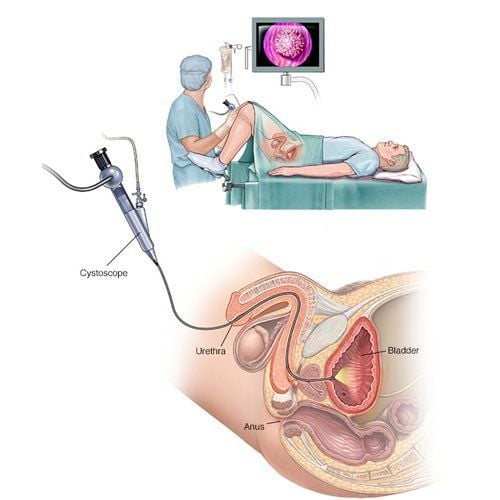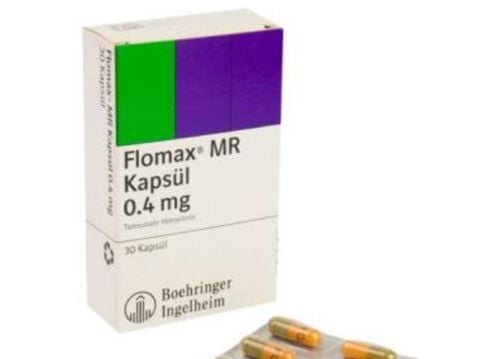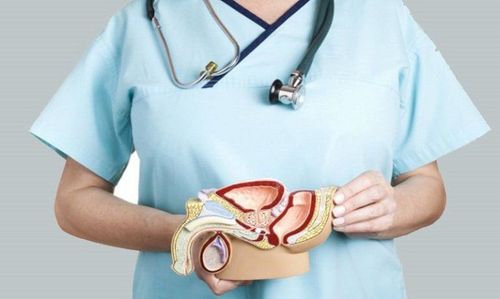This is an automatically translated article.
The article was professionally consulted by Specialist Doctor I Nguyen Thanh Hai - Radiologist - Department of Diagnostic Imaging and Nuclear Medicine - Vinmec Times City International General Hospital. Doctor Hai has more than 20 years of experience in the field of diagnostic imaging, especially in the field of multi-slice computed tomography, magnetic resonance.Prostatic hypertrophy or benign prostatic hyperplasia is a common disease in aging men with typical symptoms of urinary retention. If not diagnosed and treated early, it can lead to urinary tract infections, bladder and kidney damage, or urinary incontinence.
1. What is an enlarged prostate?
Benign prostatic hyperplasia (also known as Benign prostatic hyperplasia and BPH for short) is an enlargement of the prostate gland. The prostate gland is a walnut-sized gland that forms part of the male reproductive system. During ejaculation, the prostate gland secretes fluid into the urethra, which is a small tube that runs through the center of the prostate gland. When a man urinates, the bladder contracts to expel urine through the urethra.As men age, the prostate gland can enlarge, causing pressure on the urethra because the prostate gland surrounds the urethra at the exit of the bladder. This can lead to pathological conditions due to lower urinary tract obstruction: difficulty urinating, slowed flow, increased frequency, urgency to urinate, incomplete emptying of the bladder. and intermittent flow or leakage of urine.

2. Symptoms, causes and risk factors
2.1. Symptoms of an enlarged prostate
The severity of symptoms in people with an enlarged prostate varies, but symptoms tend to worsen over time. Common signs and symptoms of an enlarged prostate include:Frequent urination. Increased frequency of urinating at night Difficulty starting to urinate Weak or interrupted flow of urine Inability to completely empty the bladder Less common signs and symptoms include:
Sugar infection urinary retention Blood in the urine.

The following conditions can lead to symptoms similar to those caused by an enlarged prostate including:
Urinary tract infections Prostatitis Prostatitis Urethral stricture Scarring of the bladder neck due to complications symptoms of previous surgery Bladder or kidney stones Problems with the nerves that control the bladder Prostate or bladder cancer.
3. When to see a doctor?
If you are experiencing urinary problems, seek medical attention at reputable facilities as soon as possible. Even if you don't experience bothersome urinary symptoms, it's important to identify or rule out any potential causes. If left untreated, urinary problems can lead to urinary tract obstruction. If you are unable to urinate (urinary retention), you need to seek medical attention immediately.
4. Causes of Prostate Enlargement
The prostate gland is located below your bladder. The tube that carries urine from the bladder out of the penis (urethra) passes through the center of the prostate gland. When the prostate gland becomes enlarged, it begins to block the flow of urine.Most men have a prostate that will continue to grow throughout life. In many men, this continued growth enlarges the prostate enough to cause urinary symptoms or significantly obstruct urine flow. However, scientists still do not understand what causes an enlarged prostate gland. However, it may be due to an imbalance or change in the balance of sex hormones as men age.
5. Risk factors for prostate enlargement
Risk factors for an enlarged prostate include:Aging: An enlarged prostate rarely causes signs and symptoms in men under the age of 40. About a third of men have moderate to severe symptoms by age 60, and about half have such symptoms by age 80. Family history: Having an immediate relative, such as a father or brother Having a prostate problem means you are more likely to have it too. Diabetes and cardiovascular disease: Studies show that diabetes, cardiovascular disease, and beta-blocker use can increase the risk of prostate enlargement. Lifestyle: Obesity increases the risk of prostate enlargement, while exercise can reduce this risk.

6. Common imaging tests and tests for benign prostatic hypertrophy
Early diagnosis of an enlarged prostate is important, as if left untreated it can lead to urinary tract infections, bladder or kidney damage, bladder stones, and urinary incontinence. In addition, distinguishing an enlarged prostate from more serious diseases such as prostate cancer is also important.Indicated tests and diagnostic techniques vary from patient to patient, the following are the most common diagnostic techniques and tests:
Fill in the questionnaire: The physician is most interested in the degree of the severity and type of symptoms you have, and how much they affect your life. As a result, your doctor will give you a simple questionnaire to answer about your current symptoms. Evaluation of Urine Flow: In this test, the patient urinates to empty the bladder and measure the amount of urine that has been passed. A special device can help doctors detect decreased urine flow associated with an enlarged prostate. Digital Rectal Examination (DRE): The doctor puts on gloves and inserts a finger into the rectum (located next to the prostate) and palpates to feel the back of the prostate. Prostate cancer can sometimes be found when the doctor feels a lump or bump on the surface of the prostate during this test. Prostate-specific antigen (PSA) blood test: Elevated levels of PSA in the blood can sometimes be a sign of prostate cancer. Cystoscopy: In this technique, the doctor inserts a thin tube with a small camera at the tip into the urethra at the tip of the penis and toward the bladder. The camera allows the doctor to examine the inside of the prostate, urethra, and bladder.

You can perform a diagnostic examination for prostate enlargement at Vinmec International General Hospital for the following reasons:
Vinmec International General Hospital is equipped with a modern ultrasound system, has a flat probe, high frequency, HD resolution for clear images, helping to accurately detect lesions. There is an advanced laboratory system, meeting international standards. Along with that is a team of leading experts with extensive experience in the field of urology. Patients with prostate cancer after examination will be consulted to choose the appropriate treatment method. To detect prostate enlargement, the patient needs to be asked about the disease, clinical examination and necessary paraclinical tests.
Please dial HOTLINE for more information or register for an appointment HERE. Download MyVinmec app to make appointments faster and to manage your bookings easily.
References: radiologyinfo.org, mayoclinic.org














